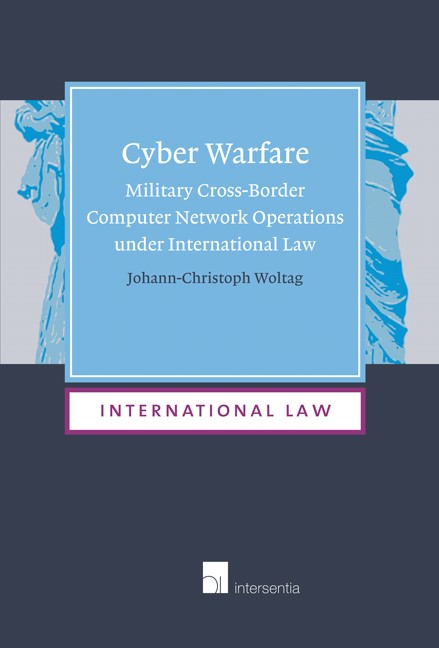Book contents
- Frontmatter
- Dedication
- Acknowledgements
- Contents
- Abbreviations
- Introduction
- PART I THE INTERNET AS A UNIVERSAL YET TERRITORIALISED INFRASTRUCTURE
- PART II THE LEGAL QUALIFICATION OF COMPUTER NETWORK OPERATIONS
- Chapter 3 Computer Network Operations Outside of Armed Conflict
- Chapter 4 The Justified Use of Forceful Computer Network Operations
- Chapter 5 Computer Network Operations During an International Armed Conflict
- Chapter 6 Neutrality in Cyber Warfare
- PART III CONCLUSION
- Bibliography
Chapter 5 - Computer Network Operations During an International Armed Conflict
from PART II - THE LEGAL QUALIFICATION OF COMPUTER NETWORK OPERATIONS
Published online by Cambridge University Press: 28 November 2017
- Frontmatter
- Dedication
- Acknowledgements
- Contents
- Abbreviations
- Introduction
- PART I THE INTERNET AS A UNIVERSAL YET TERRITORIALISED INFRASTRUCTURE
- PART II THE LEGAL QUALIFICATION OF COMPUTER NETWORK OPERATIONS
- Chapter 3 Computer Network Operations Outside of Armed Conflict
- Chapter 4 The Justified Use of Forceful Computer Network Operations
- Chapter 5 Computer Network Operations During an International Armed Conflict
- Chapter 6 Neutrality in Cyber Warfare
- PART III CONCLUSION
- Bibliography
Summary
INTRODUCTION
In relation to the history of warfare the codification of humanitarian law is still a rather new phenomenon. However, the sources of international humanitarian law reach far back into religion, philosophy or chivalry of many cultures, emphasising that humanitarian law is a common theme of all humankind. Although these instruments show that this body of law is highly codified, customary international law still plays a major role therein. This is emphasised by the fact that most of the major States recently participating in international armed conflicts have not ratified the Additional Protocol I to the Geneva Conventions of 1949, although it has otherwise gained a high ratification record of 170 States.
The applicability of humanitarian law – or ius in bello – is activated by the factual existence of an armed conflict, as stated in common Article 2 Geneva Conventions of 1949, which due to their ratification by practically all States are universally binding. In renunciation of the just-war theory, the ius ad bellum does not have an effect on the ius in bello. Both frameworks must rather be treated completely separately, providing for the full equality of both sides during an armed conflict, whatever the reason or justifications put forward for the outbreak. Actions taken in self-defence under recourse to Article 51 UN Charter can thus nevertheless still qualify as illegal under humanitarian law. Naturally, the question arises as to what scope the term ‘armed conflict’ has. This question was and still is highly disputed regarding traditional warfare. When it comes to conflicts solely confined to computer network operations exclusive of kinetic weapons, the existence of an armed conflict – cyber warfare – will be even more difficult to establish.
The term ‘armed conflict’ was intentionally substituted for the term ‘war’ in international instruments since the 1949 Geneva Conventions. This was done in order to prevent States from claiming that a forceful action would not qualify as a war in the sense until then accepted. The wider definition of armed conflict makes any situation formerly termed ‘war’ a fortiori qualify as an armed conflict. Oppenheim defined war as a ‘contention between two or more States through their armed forces, for the purpose of overpowering each other and imposing such conditions of peace as the victor pleases’.
- Type
- Chapter
- Information
- Cyber WarfareMilitary Cross-Border Computer Network Operations under International Law, pp. 197 - 258Publisher: IntersentiaPrint publication year: 2014

